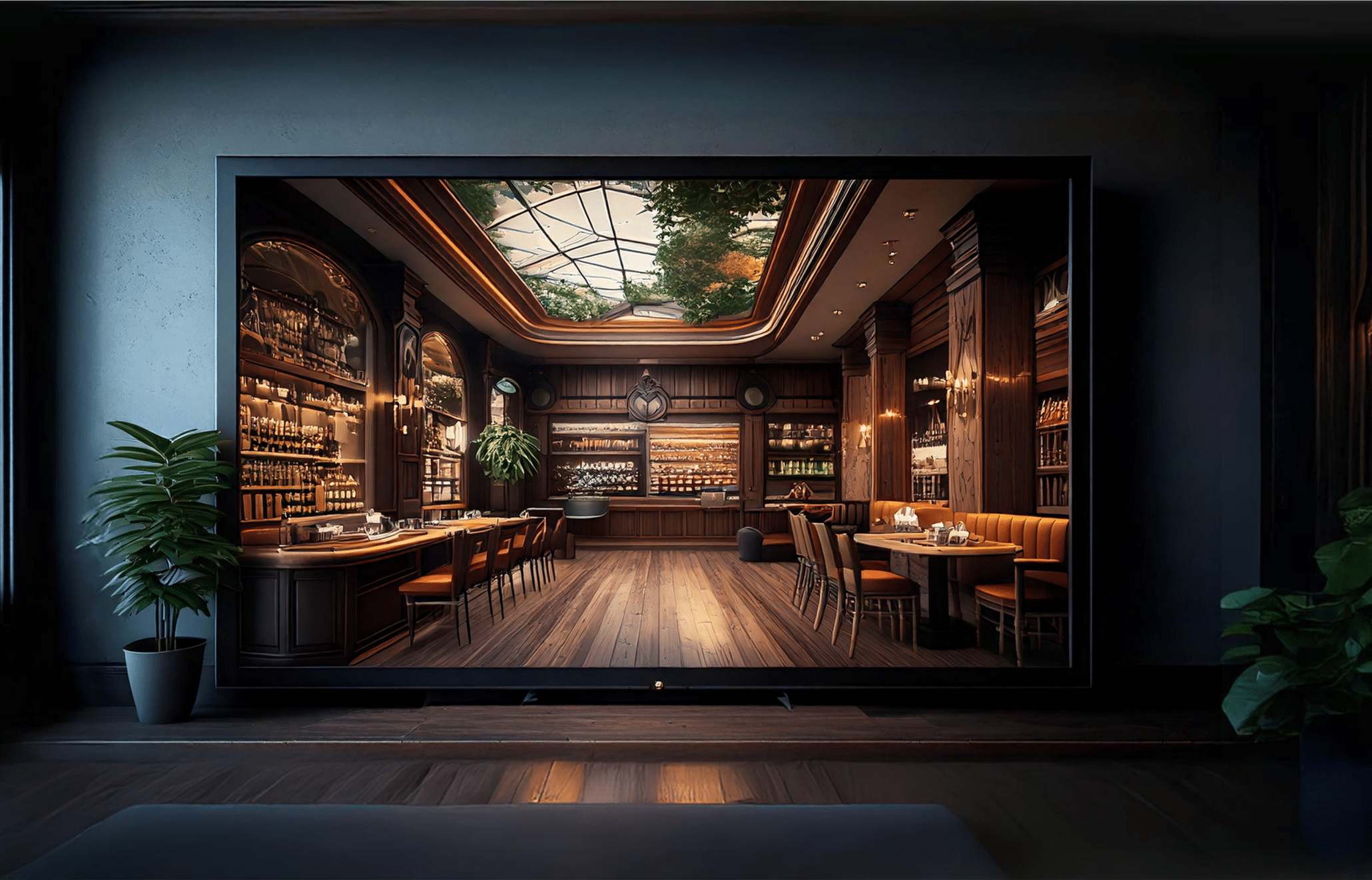Sample Strategy: How To Target CTV/OTT For Your Restaurant
How do you connect a local community to your restaurant with TV Advertising? Leveraging Connected TV/OTT is crucial. This form of TV advertising gives you tight geographic control – after all you don’t want to serve ads to individuals who will never drive the distance to visit your restaurant. But geo targeting for your restaurant is only a starting point – proximity alone doesn’t mean you should pay to advertise to someone.
We hope this guide helps you identify how Connected TV or OTT can give your restaurant the high-impact TV advertising it needs, while making full use of the available technology to have the best chance of success.
Defining Your Geography
Individuals who are most likely to be your potential customers, where do they live? How far do you think someone would be willing to drive or commute to visit your restaurant? These are basic assumptions to get you started, but they’re also worth testing (scale can often mean efficiency).
Some of how you define a geography will be based on the platform you use. Many ad platforms are only capable of targeting a radius around your location, or might be as granular as zip codes targeting. This works well for some use cases, but sometimes you need more precision. We’ll show you both.
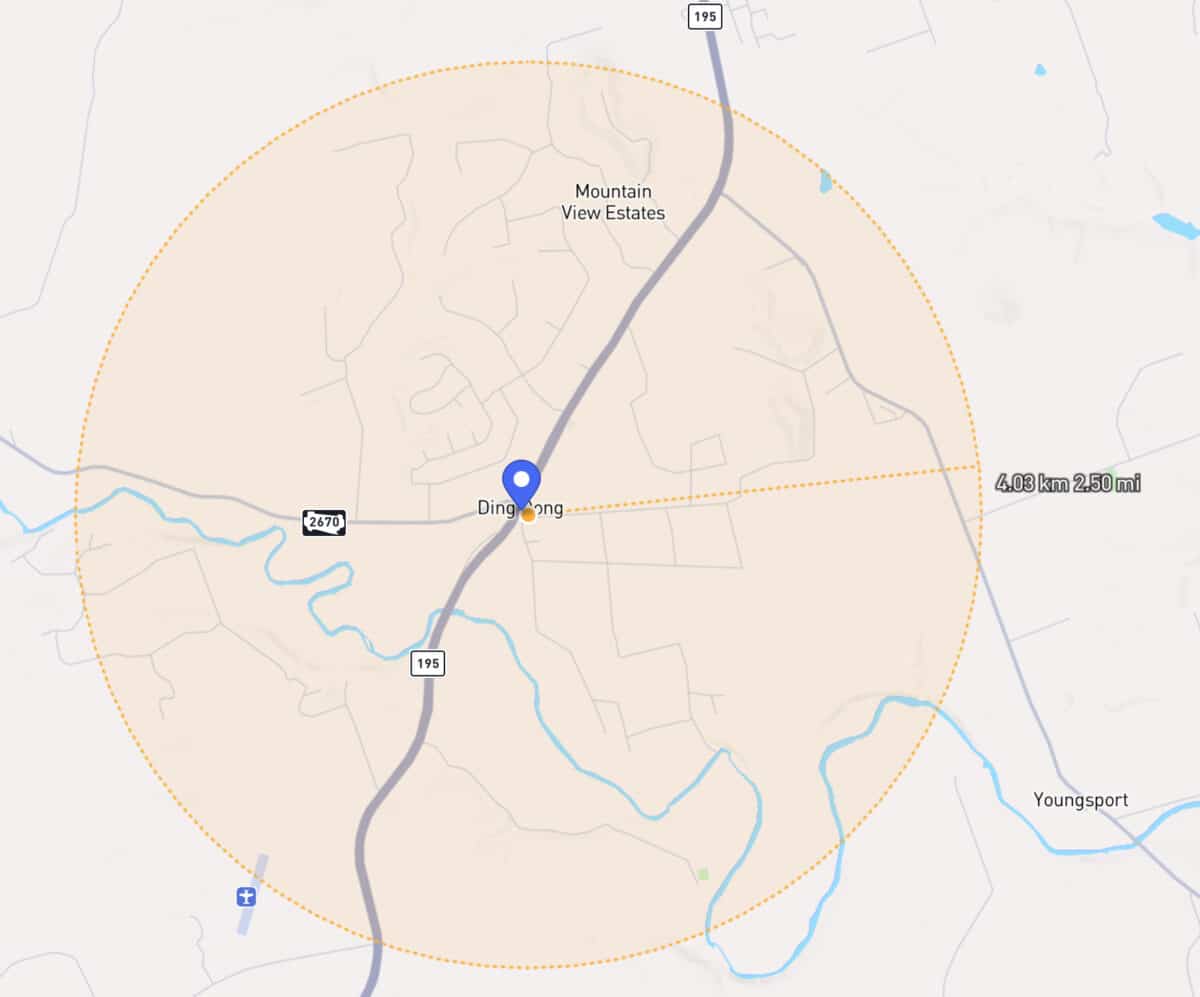
Radius, Zip and Broad Geo Targets
Radius targeting should be available to you in most platforms. This provides you the ability to reach individuals or households within a certain radius that you select. For example, this is a 2.5 mile radius around Ding Dong, Texas.
Zip code targeting is also viable, but do keep in mind: is the whole zip code your target? Also does the zip code provide enough coverage? In many areas, zip codes are a messy puzzle – you should validate that your targeting does not miss key areas or need additional zips targeted to satisfy your intended target area.
Both radius and zip code targeting lack the precision of polygon-based geofences (next heading), but for general coverage or getting started, both radius and zip code are still acceptable.
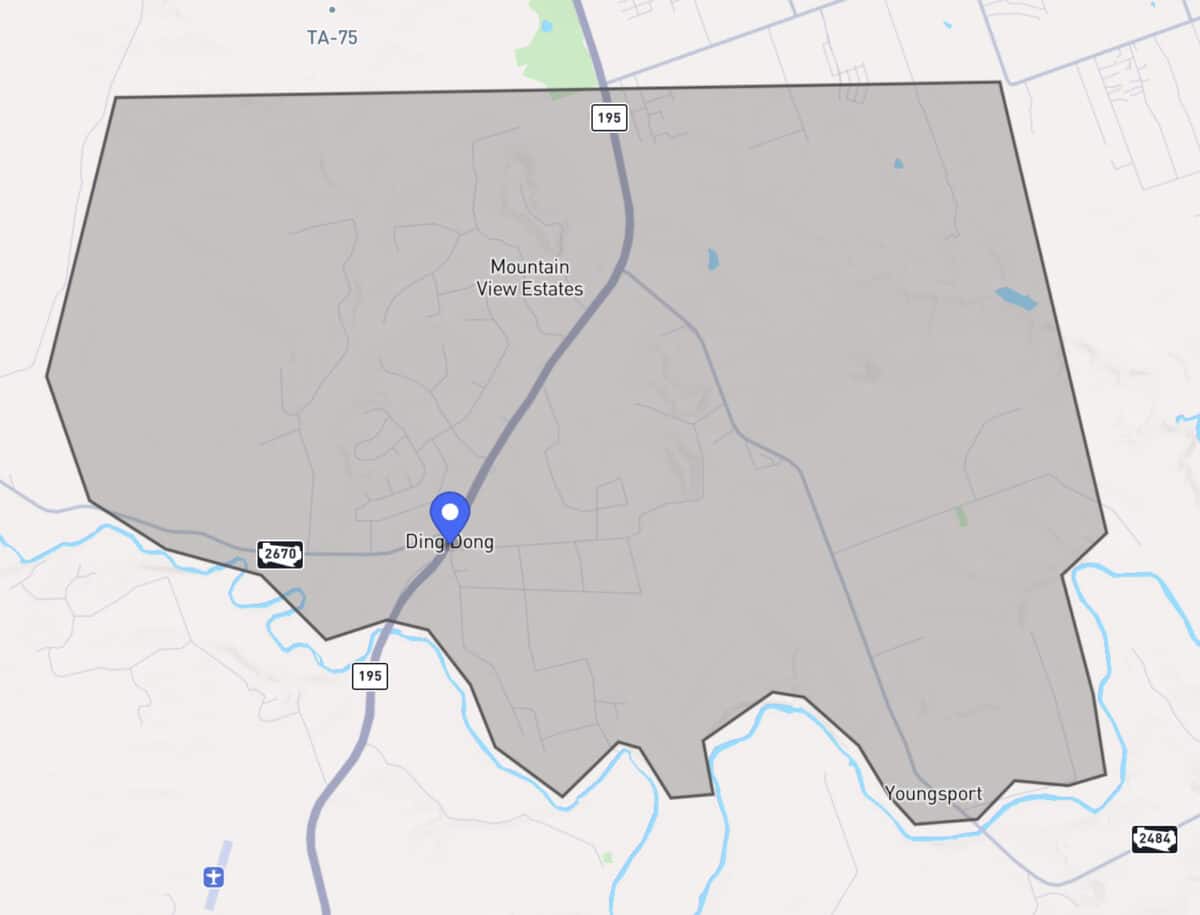
Custom Geofence / Polygonal Targeting
For more precise targeting needs, polygonal targeting is the route to go. This form of targeting allows a marketer to draw a specific zone around locations on a map. This is frequently used to only target certain neighborhoods, to avoid features like a bridge/river crossing, or even to avoid lower-quality impressions (ex: avoid placing ads in a commercial area that neighbors a residential area – radius targeting could overlap both zones). What’s that look like in practice?
In this example, we want to target the Ding Dong, Texas area – but we don’t want ads to serve south of…. That little creek or river, whatever that map feature is. Radius targeting has no chance of minimizing overlap with conditions like this! For advanced geographic targeting, use polygonal geofences.
Additional Geofence Strategy Examples
Here’s some additional examples for how to leverage custom geofences / polygonal targeting. These are primarily used for:
- Targeting individuals who live in the geofence, but not those who are transient/traveling through.
- Targeting individuals who have recently been located in the geofence area.
- Targeting individuals who are currently physically located in the target geofence area in real-time (mostly OTT inventory)
- Many other targeting methods based on location, proximity and history. This can be neighborhoods, city blocks, large buildings, congressional district targeting, and basically anything else.

Example: Custom Political Geofence Targeting for people who live in Nevada’s 1st Congressional District (and not the millions of tourists in this area)

Example: Custom Geofence for people who live only in this section of Brooklyn, between specific streets as landmarks.
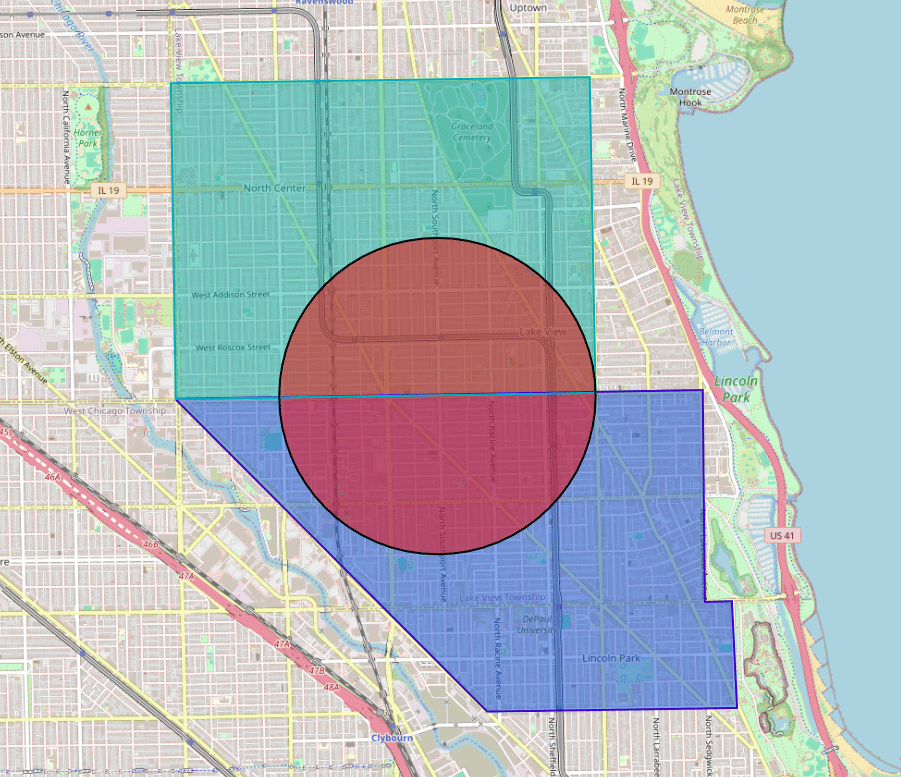
Example: Geofence targeting for residents near Chicago’s Lincoln Park Area, but prioritize anyone in the red radius.

Example: Custom Geofence Target for the Anaheim Convention Center for people who have been there recently.
We Can take care of all this for you. our strategies are custom, dedicated to making your CTV campaign a success.
Defining Your Audience
Your target customer is not everyone. It’s most certainly not everyone within a target geography. Even if your audience were “everyone” (it’s not) it’s extremely unlikely that you have budget to reach them all. We define key audiences in marketing to focus our messaging, appeal and impact to certain groups of people who are the most likely to connect with us. A good audience is comprised of:
- What defines your most frequent customers? What about your most valuable customers?
- What are common threads across your customers that makes you appeal to them?
- What product/service offering do you have that has the most appeal? Why? To whom?
Dig deep when answering these questions. Example: a particular pizza place doesn’t have appeal to weeknight parents because it’s pizza. There’s ample choices there. A pizza place likely instead has this appeal to parents because you solve a problem: dinner. And you solve this dinner problem within a reasonable price, provide a reliable product, and do so within a reasonable commute or delivery window. You make the kids happy, which makes parent happy.
Parents with kids aged 7 to 15 who live or commute nearby would constitute a specific audience, and this might be one of several audiences that are useful for targeting.
Think of an audience this way: “Would my strategy work better if I spoke to this group of individuals differently from my other customer types?” If so (and assuming the audience is large enough to be relevant) it likely justifies its own strategy.

Before moving on, some important context: an audience is anonymous. Our audiences can be very granular and are far more precise than most self-serve ad platforms will allow you to use. We won’t build audiences small enough that it reveals specific individuals or households. Some examples in this article are based on our data, which is used for targeting only on our platforms. Our targeting and audience data is not for sale, nor do our advertisers ever possess it. We have strict policies that must be adhered to for audience targeting, particularly around some sensitive data types. Ultimately, the decision to approve or reject an advertiser’s audience request is ours.

An Audience Defines a Person or Household
Like geographic targeting defines where someone is, audience targeting defines who someone is. This can be defined based on an enormous range of targeting choices. Your choices can vary drastically based on your advertising platform. Common types of audience targeting data includes:
- Household composition (parents, children, elders, etc)
- Purchase behavior (major recent purchases, where they shop, frequent purchases from major retailers, things the household has researched purchasing)
- Recent behavior (things the household has researched, viewed online, recent places they’ve been, how they vote)
- Financials (income, number of income earners, credit card count/debt/behavior, home owner/renter status)
- And many, many other datapoints

Not all ad platforms will have these features. Most ad platforms will hide the true targeting data in a black box and call it something like “in market for pizza” or “interested in pizza” without telling you what actually constitutes that audience. Audience data is not refreshed in real-time, so an “in market for pizza” audience from some ad platforms may be a super-exclusive list of…. everyone who’s bought pizza.
That’s not a good audience.
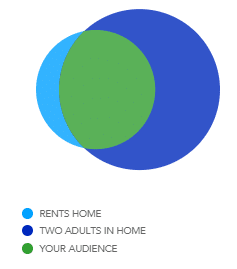
Defining A Better Audience
As previously mentioned – an audience should represent a certain set of individuals based on shared traits that makes sense to message to separately.
Think of a Venn diagram for how your audience is constructed, or a set of OR/AND logical conditions:
Renters (Rents Single Family Home OR Rents Rents Townhome OR Rents Condo)
AND
Two Adults in Household (Married OR Cohabitating)
Dynamic Audiences & Lookalike Modeling
Most ad platforms will have capabilities to analyze your website traffic and develop a targeting profile based on this. This is usually done by having a tracking code installed (we use this as well) that sees anonymous browsing behavior from your website visitors, as well as goals they complete on your website (like tap to call, reservation scheduling, getting directions, etc.). Based on this data, a dynamic model of who your typical website visitors are, and who among them are the most likely to complete website goals, an ongoing targeting audience can be generated. This is also referred to as a conversion lookalike model.

Some platforms do this well. Much of the targeting ability for dynamic audiences and lookalike modeling relies on two things:
- The quantity of visitors
- a larger sample size is better, always!
- The quality of the setup and tracking
- if you track goals on your website, the quality of data will be better
- it’s like telling the ad platform’s tracking code “all of my website traffic has some value, but everyone who clicks to call or get directions is way more valuable, so find me more of those people.”
Additional Audience Targeting Examples
Here’s some additional examples for how to leverage custom audience logic. These can be used to create a unique profile of desirable behavior that aligns with key customers:
- Target parents with children in the household ages 7-14, prioritizing those who frequently dine out.
- Use Audience Targeting to deliver different messaging to different types of customer (more on messaging in the next section)
- Individuals who are single: promote a carryout special, allowing messaging to focus on low price point.
- Households with children: promote a family meal deal special for school nights.
- Use Video View retargeting to serve your CTV ad to households who have seen your ad within the last week. This will build frequency and make them remember you more. Exclude anyone who has seen your website (this is a separate audience)
- Target households where anyone in the family visited your website within the last month. A young adult in the home saw your Facebook post about a promo and visited the site? Great! Now with CTV the whole household can see your video ad on TV!
Remember, relevancy is extremely important – so combine a target audience (who you’re reaching) with a message tailored for them (what you’re saying to them).

Example: Target individuals who dine out in restaurants regularly, but only the subset of these people who also frequently purchase health food Consumer Package Goods (~4% of the Commonly Dines Out group). This group could also be excluded.
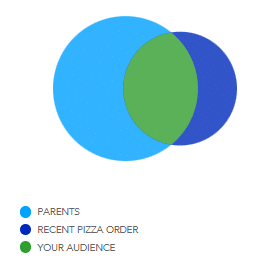
Example: Of the targetable parents, about 37% have made a pizza order recently (within the last 60 days, give or take).
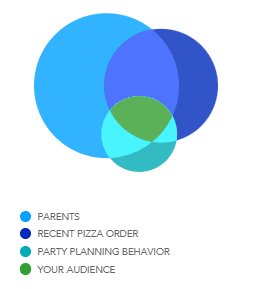
Example: Same as the last example, but now we’re also adding party-planning behavior, representing only about 10% of targetable parents (with a recent pizza order AND party planning behavior)
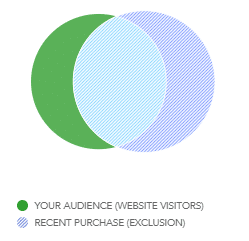
Example: A remarketing audience is commonly used to keep your product/service top of mind – but it’s also polite to stop remarketing when some conditions are met. Ex, pause remarketing for a week or two when the target household buys with you.
Critically important: audiences need to be tested! Our advertising specialists have been using the best-in-class industry tools for years, and there’s seldom a situation where an audience is perfect on day one – even for us. They need testing, and ongoing optimization. That’s a benefit of our targeting precision and tools – we can see all the audience components and make updates based on CTV/OTT campaign performance data – other platforms are seriously lacking in this regard.
There’s a lot that can be done – our advertising strategists would love to make a recommendation based on our experience.
Leverage Our Best-In-Class Targeting Capabilities.
Your audience is unique. Your targeting strategy should be too.
Defining Your Messaging
Your geographic targeting is where your customers are. Your audience targeting is who they are. Your messaging – that’s the part of your advertising that your potential customers actually see. That’s your brief moment where you have their attention, so what will you say? What’s the compelling message? Why should they care?
As we mentioned, relevancy is extremely important. Your ad is interrupting their day, so use it well and respect the target audience’s time. We spent a lot of work above defining our geographic targeting and audience, so let’s not waste that work on low-effort messaging.
Again, take a step back and identify who the audience is, and why you should matter to them. You’re not selling pizza, you’re solving a problem. So, what is the problem your pizza solves, and how is that problem solved for different audiences?
- For your audience of parents with children in the household ages 7-14 who frequently dine out
- School Night Special. Provide a family meal deal, or assemble a sample menu “feeds a family of four for only $X”
- Test an alternate creative that has two offerings, with a high and low price. This can help avoid fixation on price. Or, test messaging where you simply don’t mention price and include provide a “mention this ad to save $X”
- Based on your audience targeting, change messaging:
- Individuals who are single: promote a carryout special, allowing messaging to focus on low price point. Your video creative should be framed around either a single person or a young couple (dating couples are still flagged as single – or we can more precisely target just that). Use talent that speaks to this audience.
- Households with children: promote a family meal deal special for school nights, leverage a family in your creative. Of particular interest in the video, focus on the kids (the ones who will demand pizza night) and the mom (generally the one to pick up the phone). For mom, you likely want her to be in control and pleased that pizza night has made her evening easier!
- Have a customer database? Awesome! That pairs very well with a “frequent flyer” reminder video format. A CTV video ad targeting the household of existing customers can keep them coming back, particularly if you pair this targeting with messaging about loyalty rewards, a new menu item, or the return of an old favorite.
Just like when you were thinking of an audience “would my strategy work better if I spoke to this group of individuals differently from my other customer types?” think of messaging the same way. Each audience type will work best if it has dedicated messaging. This is of course an expense – it costs time and resources to produce video ads – so start with general messaging that could work for several audiences, then in time refine your messaging to cater to specific audiences.

Your video messaging is your public face! The geographics and audience targeting of your campaign is the hidden engine that powers your media, but the video creative is what makes the connection with your audience. Make your video matter! See our guide for producing your own Connected TV video resources.
Testing Creative
We’ve discussed having video messaging that speaks to a particular audience, but how do you know that a given message is the best message to use for an audience? Testing!
Connected TV, as opposed to traditional television, gives excellent data about the engagement with and results from your video ads. This means that even with a single audience (ex: parents and their kids/pizza problem) you can test two (or more) video messages and measure the results. Here’s key points about measuring the difference between A/B testing video creatives:
- Compare Peers – first, only compare videos against their peers within the same audience. Video A serving to Pizza Parents vs Video B serving to singles is not a comparison about the video itself as there’s multiple variables at play.
- Sample Size – if you have a very small, focused audience, you may not have enough scale to justify testing multiple ads. If it would take months of ad serving for you to have enough data to realize the results, your audience is too small.
- Compare Same Metrics – comparisons need to be data-driven and consistent, so when evaluating an experiment, keep the comparison objective. Compare both videos on the same metric. Ex: not “Video A is better at View Rate but Video B is better at generating searches.” That’s an observation, not an experiment.

What Makes A Good Connected TV Video Ad?
CTV as a format should be treated a bit differently from In-Stream or other digital video formats. Here’s some general rules of thumb to follow:
- While timing is flexible, a :15 or :30 spot will allow you to place into more inventory
- Most CTV ads will play with audio on, so make full use of the audio experience
- Localization is extremely important! Make sure individuals who are receiving your ad understand the relevancy to you, not just their interest but the fact that you’re nearby!
- Use a clear call to action and tell the viewer what you would like them to do. “Visit us at…” or “mention this ad to save…”
- It does not need to be a high-end production. An expensive look has its place, but also understand there is perceived value, authenticity and human connection in less-polished video ads.

On our CTV inventory, most people will view the whole ad. Make it worth their while.

Connected TV ads have additional specs & requirements that must be met in order to serve across our vast access to networks. Failing format requirements means we either must reject your ad, or it may not be eligible to play on Premium inventory like Hulu or others. See our specs & requirements documentation to ensure your video creative meets our expectations.
Additional Creative & Messaging Examples
Here’s some additional examples for how to leverage custom audience logic. Steal these thoroughly-proven concepts:
- Behind The Scenes: People love to see what they normally wouldn’t! From Guy Fieri’s DDD to How It’s Made, people love to see this content. Demonstrate the quality of the food and showcase your chef(s) or kitchen staff telling the audience why X is their favorite dish
- Human Connection: Expanding on the above, what unique twist or cultural impact story does your chef have to share? Introduce your head chef and demonstrate their passion for food.
- Food in Focus: Show high quality imagery or video of your food, with particular attention paid to vibrant colors and the texture. Don’t do this if your food photography skills are weak, or you might put people off their appetite. Properly lit and high quality imagery will make viewers hungry! Pair this with promotional messaging for your dish.
- Seasonal Offerings: Highlight new (especially temporary) additions to your menu, and especially indicate if they are limited time offerings. Don’t provide a specific date that a seasonal menu ends – this instills a sense of urgency that something might be missed if not acted on soon. A limited time offering gives viewers a fear of missing out, and the feeling of participating in something unique if they choose to visit. This creative type works great for targeting your existing customer audience!

You have the first five seconds to hook your audience. Try starting with excitement or a question.

Human connection is very important. Viewers can relate to and form a connection with a person, not a picture of your building. Use people!

Remember there are multiple ways someone may want to buy, but you don’t need to cram it all in the same ad. Take Out vs Dine In, these might be separate ads.

Our ads learn over time. Generally, ads that exist for a longer period of time can work better than short term ads.
Critically important: audiences need to be tested! Our advertising specialists have been using the best-in-class industry tools for years, and there’s seldom a situation where an audience is perfect on day one – even for us. They need testing, and ongoing optimization. That’s a benefit of our targeting precision and tools – we can see all the audience components and make updates based on CTV/OTT campaign performance data – other platforms are seriously lacking in this regard.
Leverage Our Best-In-Class Targeting Capabilities.
Your audience is unique. Your targeting strategy should be too.
Bringing It All Together
The key elements when you create your successful Connected TV (CTV) strategy for a restaurant require a focus on geographic, audience, and messaging alignment.
First, identify your target area: reach people who live, work, or travel near your restaurant to ensure relevancy. Second, refine your audience based on specific customer profiles, so you can eliminate irrelevant viewers and tailor content for optimal engagement. Lastly, develop impactful messaging that encourages action, and emphasizes locality to inform your viewers that you’re nearby.
Geographic Targeting: Define the specific area around your restaurant that yields the most potential customers. Focus on neighborhoods where people live, work, or frequently visit, as this increases the chance that viewers will find your location convenient and accessible. Tailor your ads to reach only the most relevant geographic areas to avoid wasted impressions on people unlikely to visit.
Audience Selection: Identify the various types of customers who frequent your restaurant, such as families, young professionals, tourists, or regular diners. Leverage CTV’s audience selection tools to exclude irrelevant demographics and focus on those most likely to engage. By zeroing in on these sub-groups, you can further personalize your message, increasing its resonance with viewers who are most receptive.
Messaging: Develop concise, action-oriented messages that directly address the viewer and prompt them to take a specific action, such as “Come dine with us tonight!” or “Order online for pickup nearby.” Emphasize local aspects in the message, mentioning proximity landmarks, cross streets or neighborhood names to help viewers immediately recognize that your restaurant is a nearby option, making it easier for them to take the next step in visiting or ordering. Authenticity matters more than a high-end polish, keep this in mind.
Remember, relevancy is extremely important – so combine a target audience (who you’re reaching) with a message tailored for them (what you’re saying to them).

